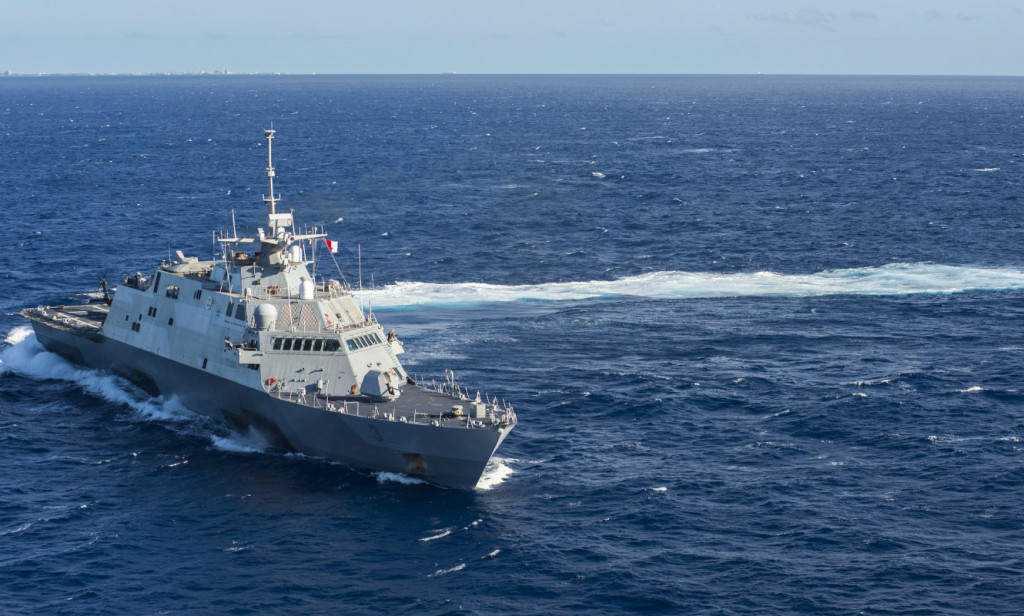

Secretary of Defense Ashton Carter’s recent memo to Secretary of the Navy Ray Mabus detailed cuts to the Littoral Combat Ship (LCS) in order to pay for a collection of new and legacy platforms and payloads. The memo has drawn wide interest and generated much speculation about the future of the LCS. Despite this cut, LCS opponents should not yet be too jubilant. Secretary Carter expressed satisfaction with the LCS in his memo, and the program continues forward with a robust 40 units as opposed to the planned 52.
In 2014, former Secretary of Defense Chuck Hagel ordered a limited “transformation” of the LCS from a ship with most of its capabilities in dedicated mission modules to a more heavily armed frigate with its warfighting capacity permanently installed. Much more can be done in a relatively inexpensive manner to make the ship more lethal, especially through the addition of long-range anti-ship cruise missiles. Such an update to the LCS obviates the need for a $1-billion large traditional frigate or a mass of short-range, 1,000-ton corvettes without helicopter facilities. The LCS is frequently criticized as “unsurvivable” in comparison with larger ships. However, even in its baseline form, it possesses a more robust defense against anti-ship cruise missiles than the now retired Oliver Hazard Perry-class frigates did in their final configuration.
The Carter memo essentially instructs the U.S. Navy to rapidly modernize its fleet escort air defense capability in order to counter modern anti-ship cruise missiles, add greater strike capabilities to the Virginia-class submarines, and purchase more carrier aircraft. The deficiencies in advanced offensive and defensive weapons and aircraft described in the memo are primarily in the major surface combatant force and naval aviation. The LCS program itself is not criticized; only the number of ships to be produced is reduced. To his credit, Secretary Carter describes the LCS as “a far more modern and capable ship than the patrol coastal ships, minesweepers (actually mine countermeasures ships), and frigates that they replace.” His targeting of the LCS alone to fund the improvements in offensive and defensive capabilities required in the memo could, however, paint a larger bullseye on the program and encourages more opposition in Congress and the defense community to the 40 remaining ships.
The United States Navy needs a variety of capabilities to be effective as a component of a modern joint force. The slippage in the range and lethality of carrier aircraft, the offensive and defensive components of surface ships, and the strike attributes of the submarine force did not happen during the tenure of the present Navy secretary, or even during that of his predecessor. These trends have been ongoing since 1991, when the United States essentially decided that all future conflicts would be joint and combined air–ground task force operations around the Eurasian littoral within the range of land-based aviation. U.S. naval forces must be rebalanced to meet new threats. The Carter memo describes this effort. Its exclusive focus on cuts to the LCS force, however, may further endanger this vitally needed program, and its forced choice of only one LCS variant by 2019 could seriously impact the losing shipyard. The U.S. Navy cannot field a fleet of only high-capability ships. LCS still represents the best and most economical choice to produce a large number of lower-capability warships needed for escort and low threat area missions.
Steven Wills is a retired surface warfare officer who spent most of his operational career in small combatants including frigates, mine countermeasures ships and patrol coastals. He is a PhD candidate in Military History at Ohio University, Athens, OH. His forthcoming dissertation is entitled, “Replacing the Maritime Strategy, The Change in U.S. Naval Strategy from 1989-1994.”
